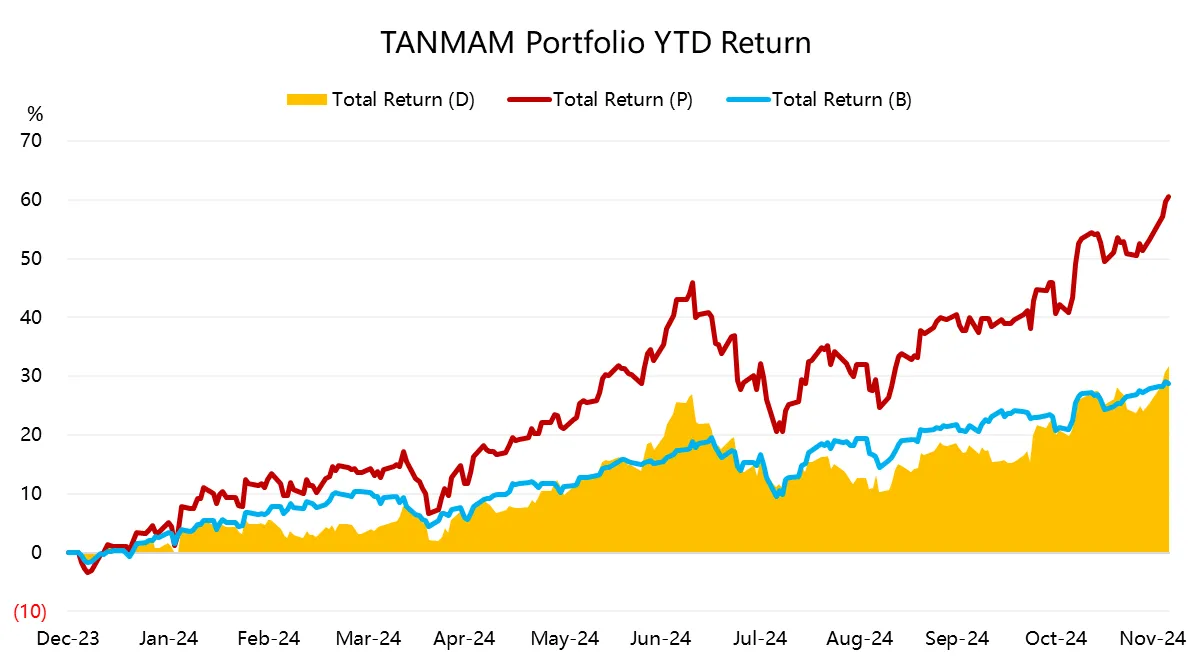Big-Tech’s Performance
Entering December, investors began to sprint for yearly gains, and the annual Christmas market seems to be previewed in advance.On the one hand, the U.S. dollar remains at the high end of the rally, the international macro events increased, the risk aversion attribute of the U.S. dollar funds once again reflected; on the other hand, risky assets are extremely active, BTC broke through the $100,000 mark, U.S. growth stocks are active, and big tech is also leading the broader market to new highs.
To the close of December 5, the past week, the big technology companies as a whole soared. $Apple(AAPL)$ +3.45%, $NVIDIA Corp(NVDA)$ +7.18%, $Microsoft(MSFT)$ +4.64%, $Amazon.com(AMZN)$ +7.2%, $Alphabet(GOOG)$ $Alphabet(GOOGL)$ +2.02%, $Meta Platforms, Inc.(META)$ +6.98% and $Tesla Motors(TSLA)$ +10.99%.
Big-Tech’s Key Strategy
Why U.S. stocks are in "HOLD" now? Take AAPL as an example
Apple's company performance and stock price is actually very representative of the current market investor sentiment.On the one hand, there is a preference to continue to chase highs or even "FOMO", and on the other hand, they are beginning to be wary of a post-craze pullback.
From the general direction, the market began to trade is the expectation of 2025, the market also repeated record highs, but counting the "good" than "risk".For example, the market is starting to trade on a number of possible benefits of a new administration, such as tax cuts and de-regulation, but less on the risks, such as tariffs, tighter immigration, a stronger dollar, and threats to profits.
Let's talk about the impact using a multinational company like Apple as an example.
Tax cuts: The Trump administration is expected to lower the corporate tax rate, which in principle could increase corporate profitability, but the effective tax rate for large corporations is quite a bit lower than the corporate tax rate, and the share of overseas business is not low, so the actual effect will be limited;
Tariffs: any tensions in US-China relations are likely to involve Apple, as 17% of its revenues come from Greater China; however, good government relations actually make it less vulnerable to tariff shocks;
Declining consumption: Sales in Greater China have been weaker for the past three quarters, which may not be a problem for Apple alone, but the point is that consumption in other regions isn't strong either.While the market consensus expects a 4-5% growth rate in FY2025, which may actually exaggerate the effect of the new AI models, Apple's AI realization is expected to have a high degree of uncertainty and may not be specific to the new models;
Regulatory impact: EU regulation (fines) or Google's antitrust case (Safari browser default search) could have a bigger impact on Apple than tariffs, with the latter's impacting Apple's $20 billion in high margin revenue.The ruling is due in August 2025 and the market is not currently overpricing this risk.Also from a de-regulation point of view, reducing regulatory costs to reduce the deficit will also increase competition, with a portion of corporate profits fed back to consumers;
Immigration policy: the impact on Apple from a labor perspective is minimal, with its industry chain spread across the globe;
Strong dollar: tariffs may not necessarily push up inflation, but a strong dollar could lower real profit margins for companies, while a fuller pace of interest rate cuts could further reduce the company's
Additionally, for a large company like Apple, buybacks remain an important support for the company's share price.The company's buyback in fiscal year 2024 was 404 million shares, shrinking the share capital by about 2.6%, and is expected to buy back in fiscal year 2025 will be between $105 billion and $115 billion.


Big-Tech Weekly Options Watcher
This week we are looking at: a new high rush for TSLA?
Looking at the performance of its options, TSLA's Call significant resistance in Dec-Jan is at 400, and while some of the big orders have now started to roll to higher levels, the overall view is that there are more and more positions implied to be sold.While Tesla is no longer the bottom performer in Mag7 so far this year, its higher volatility has also prompted investors to gamble for new highs in yearly returns.
Big-Tech Portfolio
The Magnificent Seven form a portfolio (the "TANMAMG" portfolio) that is equally weighted and reweighted quarterly.The backtest results are far outperforming the $.SPX(.SPX)$ since 2015, with a total return of 2,439.42%, a $SPDR S&P 500 ETF Trust(SPY)$ return of 250.46% over the same period, and another record high excess return of 2,188.96%.





Comments